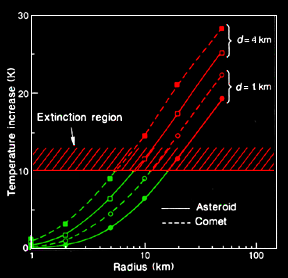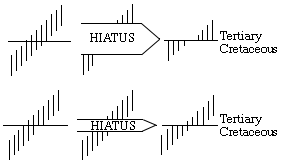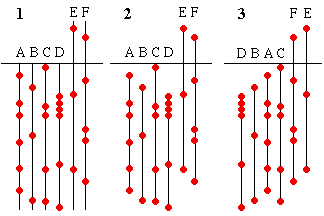
Possible impact-generated CO2 effect on the atmosphere.
BACK TO DINOSAURS 1999 HOME PAGE
Since that time (1980) it has been realized that an oceanic impact, like that at Chicxulub could have much, dire effects.
In specific, the Chicxulub bolide struck a thick deposit of marine limestone (CaCO3) and underlying marine calcium sulphate (CaSO4 = Gypsum). This probably put large amounts of CO2 and sulfuric acid into the atmosphere within minutes. The CO2 would have produced an enhansed greenhouse effect, but the sulfuric acid would result in global cooling.First, we will look at the greenhouse effect.
| In 1989 O'Keefe and Aherns estimated that the impact of a 12 km diameter comet or a 14 km asteroid would have raised the average temperature of the Earth by over 10ƒ (right). This massive heating effect would have lasted for hundreds to thousands of years, probably making the interior of continents virtually inhospitable. Eventially the CO2 would be absorbed by the oceans, plants and the wweathering process. |
 Possible impact-generated CO2 effect on the atmosphere. |
This debate breaks down into two catagories.
1. Is the pattern of extinctions actually compatible with an impact.2. Were there other things going on that might have contributed to the extinctions, or even been more important. First we will look at the biological pattern.
Signor-Lipps Effect


Deccan Volcanism
Possible CO2 effect on the atmosphere from Deccan Lavas. From Caldeira and Ramino (1990).
References
Caldeira, K. G. and Ramino, M. R., 1990, Deccan volcanism, greenhouse warming, and the Cretaceous/Tertiary boundary. Geological Society of America, Special Paper 247, p. 117-123.O'Keefe, J. D., and Aherns, T. J., 1989, Impact production of CO2 by the bolide and the resultant heating of the Earth. Nature, v. 338, p. 247-249.
Go to Lecture 26
BACK TO SYLLABUS